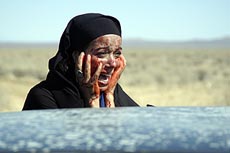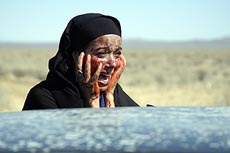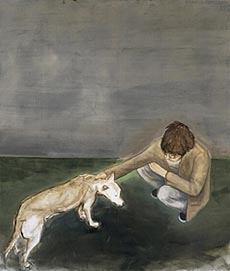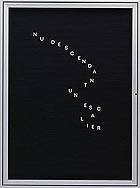
translated and summarized by: Liz Wollner-Grandville,
November 5 - 11
MUMOK - Museum modern Kunst: Omer Fast - The Casting
Between Times
Two new video installations by the Israeli artist Omer Fast are shown in the MUMOK series "Factory". In his work Fast deals with the origin of individual and collective history. Which subjective experiences are transformed into memories? Which have been on our mind our entire lives and offer a path to our own identity? Finally which of these experiences becomes part of the collective memory? Omer Fast plays with politically relevant information related to these individual stories and questions the conventional display-formats of TV and film.
The Casting produced (2006/07) combines these three levels of storytelling into one film story, which seems to be arbitrarily assembled. It is based on a story told by a US sergeant about a tragic incident in his last Iraq mission as well as an unusual encounter with a young woman in Bavaria. In a third story line Fast lets actors re-enact the interview situation and for a split second he freezes the moving images into vibrating frames. Movements are suspended in midair and words abide on the speaker`s lips. As the actors stop in the middle of their acting, illusions of past and present flow into one another and for a short while stand still.
Fast transforms the body into a territory of memory. The young woman in Bavaria cuts her skin so as never to forget and thereby translates memory into an experience of pain. In the movie The Grote Boodshap the body becomes a type of memory training camp. An old lady narrates how her father, during the Second World War, swallowed diamonds together with pills. And she talks about her mother`s jubilation about her father`s bowel movements. The old woman transforms her body into a storage center by haphazardly swallowing tranquilizers and other pills. The greed for diamonds and excretions are the main theme of this amusing 27minute loop, which captures three couples in a time warp in different rooms under the same roof.
With his films Fast undermines traditional forms of media presentation by playing with them in an absurd manner. He also focuses on the uncomfortable feeling that is induced through what is seen, narrated, and communicated through the prevalent representational forms.
(1070 Wien, Museumsquartier, until 20. January 2008)
www.mumok.at
Artlounge Strabag Kunstforum, Galerie Gerersdorfer: Robert Muntean
Without a sound
It is amazing how mature and calm the paintings of this year`s Strabag Art Award winner, the young 25-year-old Robert Muntean, are. His introverted and sensitive figures, whose eyes never meet those of the viewer, create an aura of profundity. They are positioned into colorful surroundings with no contextual association to their daily routines. Empty spaces in gradated pastel colors dominate the calm paintings. These spaces are the actual strength of his work; they do not convey emptiness but a relaxed atmosphere. The details make their quality obvious as well as the nuances of color values in which they are shaped.
Without a sound shows paintings that mainly depict musicians or people indulged in music making, easily identified in these tasks on account of Muntean`s accomplished technique. On the other hand, his animal compositions are a bit shallow, and lack the context to pop culture, which is so clear in his other works without themselves being trendy. The largest piece of work shown in this exhibit is Sonic Life. It is a tribute to the legendary band Sonic Youth, famous for its reduced sound and closely connected to Dan Graham. Muntean`s work seems less felicitous in those paintings in which he did not abstain from using requisites such as guitars, or very colorful effects - they come across as restless and too conventional. Robert Muntean is definitely one of the most talented artists of his generation and clearly indicates that we look forward to his upcoming work.
(Galerie Gerersdorfer, 1090 Wien, Währingerstraße 12; Artlounge Strabag Kunstforum, 1220 Wien, Donau City Strasse 9, until 23. November 2007)
www.gerersdorfer.at
www.strabag-kunstforum.at
Kunst Raum Niederösterreich: The enforced dress
Superficial Sensitivity
Both the press release as well as the catalogue misleadingly point to the reciprocal influence of fashion and art displayed in this exhibit. The works have little or nothing to do with fashion - with one exception. The clothing displayed has more resemblance to an outer shell, a projection screen or a narrative plane. Alice Creischer uses a type of coat as a politically correct and at the same time esthetical presentation of bio-piracy: the coat is draped with dried medicinal herbs that had planned to be patented by a pharmaceutical firm. Jochen Zeirzer uses body bags as a uniform-prototype; the handles attached to the bag facilitate the removal of the soldier`s body, how blatant can you get? And Markus Schinwald`s contorted shoes are everything but a fashion statement - he is points his finger at the way bodies are controlled through gadgetry, corsets, or footwear. In Milica Tomic`s and Roza El-Hassans works the attire represent objects that have been traumatically charged. Only Olaf Nicolai`s work reflects fashion as such: every amateur tailor can manufacture a copy of his own Armani-clothes based on the dressmaking-patterns Nicolai published in a magazine, after having numerous designer clothes re-tailored.
Even if some objects are definitely worth seeing at this exhibit, the show could have been much more concise, if the topic would have been tackled from one aspect only: either by clearly pointing to the connection between fashion and art or concentrating on the direct relationship between body and clothing. The exhibit offers a variety of avenues, but it does not go into any depth.
(1014 Vienna, Herrengasse 13, until 17. November 2007)
www.kunstraum.net
Galerie Stadtpark: Bethan Huws
The Art of Making
The Galerie Stadtpark in Krems, province of Lower Austria, opened its fall season with works by the Welsh artist Bethan Huws. Huws lives in Paris and studied linguistics and art in London. Text, film, and objects that emerge from re-evaluating existing language- and art-systems are the central aspect of her work. She goes beyond a post structural approach examining the correlation between texts and creates her own universe. This universe relates strongly to Marcel Duchamp, conceptual art of the Sixties, and her experience with Welsh as well as English and French.
"Word Vitrines" are showcases (displayed in the gallery`s main room) containing white plastic letters forming short sentences, posted on a black background. ON ON KAWARA, 31. 03. 2006 is written in one of these vitrines and beneath this the text closes with the following statement: "Fully aware of all that passes in the world around him, On Kawara chooses to sit/stand quietly painting his painting". Huws is not only referring to On Kawara`s "Today paintings", she also transforms his "Date Paintings" into simple inserted letters as one would usually only see them in public buildings or in restaurants as price-lists. With her simple and art-estranged objects elements of every-day life are integrated into the art world. Likewise Carl Andre and Sol Le Witt dealt with the demystification of an artist`s artifact and questioned both the material as well as the form used. Huws goes beyond questioning the material of an object and refers to the transience of On Kawara and his work through the usage of language. On account of these formal and content-related references, Huws finds herself in the tradition of art and incessantly questions her own doing: FIRST YOU DO SOMETHING 2. THEN YOU QUESTION WHAT YOU DID 3. THIS IS MAKING.
Other "Word Vitrines" concentrate on utilizing puns for amusing linguistic misunderstandings. The focus is on "not getting on with one another" when two people are trying to communicate. This creates humorous and sometimes even comically tragic effects. One example is the multitude of meanings of the word Mars that are responsible for some irritating moments in the short video The Chocolate Bar (2006). These absurdities characterize Huws broad and formal work, whose main objective is to "translate from one language to another, to translate into different cultures, to translate from experiences into cultures and vice versa", as the jury of the Biennial Award for Centennial Art (B.A.C.A) described her work, when she was awarded the prize in 2006.
(3500 Krems, Wichnerstrasse, until 15. December 2007)
www.galeriestadtpark.at
Mehr Texte von translated and summarized by: Liz Wollner-Grandville


 Teilen
Teilen




